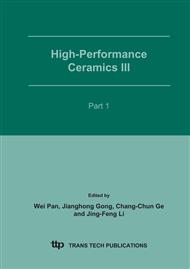p.311
p.315
p.319
p.323
p.327
p.333
p.337
p.341
p.345
Effect of Iron Oxide on the Structure, Electrical and Magnetic Properties of (70% mole V2O5- (15-x)% mole P2O5-15% mole B2O3) Semi Conducting Glass System
Abstract:
A glass system according to the molar formula (70% mole V2O5- (15-x)% mole P2O5-15% mole B2O3), where x = 0, 1, 2.5, 5 and 7.5 % mole Fe2O3, was prepared by melting the pure powder chemicals at porcelain crucibles at 1000Co for three hours until the homogenous glass was obtained. The samples were quenched in air and heat-treated at 500 Co for 1, 2 and 3 h. The density, the molar volume, the electrical conductivity and magnetic properties were measured before and after the heat-treatment. The crystalline phases due to heat-treatment were determined using x-ray diffraction. The heat-treatment causes change of BO3 to BO4 and forming non-bridging oxygen. Replacing the phosphorus oxide with the iron oxide increases the magnetic properties while the conductivity increase up to 5% mole and then decreases. The changes of electrical and magnetic properties with heat-treatment time have a random behavior due to the change of the structure if the samples with heat treatment.
Info:
Periodical:
Pages:
327-332
Citation:
Online since:
February 2007
Authors:
Keywords:
Price:
Сopyright:
© 2005 Trans Tech Publications Ltd. All Rights Reserved
Share:
Citation:


